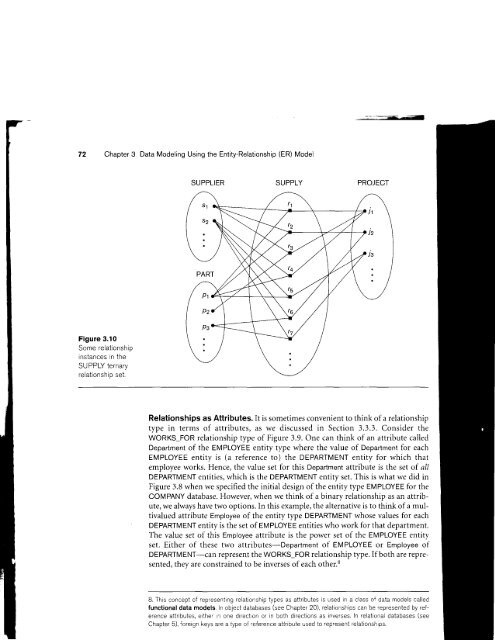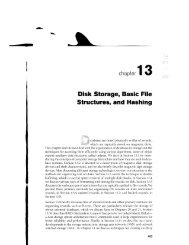this pdf excerpt
this pdf excerpt
this pdf excerpt
You also want an ePaper? Increase the reach of your titles
YUMPU automatically turns print PDFs into web optimized ePapers that Google loves.
72 Chapter 3 Data Modeling Using the Entity-Relationship (ER) Model<br />
Figure 3.10<br />
Some relationship<br />
instances in the<br />
SUPPLY ternary<br />
rplalinnchin sel<br />
SUPPLIER SUPPLY<br />
PROJECT<br />
Relationships as Attributes. It is sometimes convenient to think of a relationship<br />
type in terms of attributes, as we discussed in Section 3.3.3. Consider the<br />
WORKS_FOR relationship type of Figure 3.9. One can think of an attribute called<br />
Department of the EMPLOYEE entity type where the value of Department for each<br />
EMPLOYEE entity is (a reference to) the DEPARTMENT entity for which that<br />
employee works. Hence, the value set for <strong>this</strong> Department attribute is the set of all<br />
DEPARTMENT entities, which is the DEPARTMENT entity set. This is what we did in<br />
Figure 3.8 when we specified the initial design of the entity type EMPLOYEE for the<br />
COMPANY database. However, when we think of a binary relationship as an attribute,<br />
we always have two options. In <strong>this</strong> example, the alternative is to think of a multivalued<br />
attribute Employee of the entity type DEPARTMENT whose values for each<br />
DEPARTMENT entity is the set of EMPLOYEE entities who work for that department.<br />
The value set of <strong>this</strong> Employee attribute is the power set of the EMPLOYEE entity<br />
set. Either of these two attributes-Department of EMPLOYEE or Employee of<br />
DEPARTMENT-can represent the WORKS_FOR relationship type. If both are represented,<br />
they are constrained to be inverses ofeach other.8<br />
B. Thrs concept of representing relationship types as attributes is used in a class of data models called<br />
functional data models. In object databases (see Chapter 2O), relationships can be represented by reference<br />
attributes, either in one direction or in both directions as inverses, In relational databases (see<br />
Chapter 5), foreign keys are a type of reference attribute used to represent relationships.<br />
l1<br />
:<br />
l2<br />
le














